In PropTalk’s monthly Boatshop Reports, we chronicle regional boat builders’ projects in progress, many of which are custom-made for their clients. We reached out to a handful of custom boat builders and asked them about their clients, the process of turning a “dreamboat” into reality, the challenges, and the rewards.
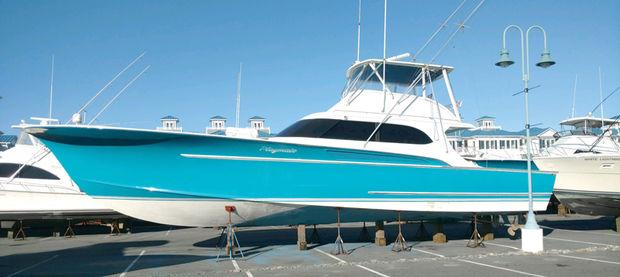
The custom client
What types of boaters seek custom boats? It depends on the builder, of course, but most custom clients have owned boats and thought a great deal about what they want in their own. “They are typically very experienced owners with full-time captains and crews,” says John Floyd of F&S Boat Works in Bear, DE. F&S builds cold-molded, hand-crafted, 40- to 80-foot fishing yachts with a variable deadrise, longitudinally stepped vee-design hull. He works with his uncle, Jim Floyd, who founded the company. “Our owners are typically folks who’ve owned very large production boats, such as a Hatteras or the like, or people who’ve owned another custom boat.” Sometimes, the client has a very specific need, such as one who was six feet, six inches tall and needed extra headroom.
Mike Glyphis at Eastern Shore Boatworks in Ocean City, MD, builds custom, cold-molded fishing boats. His customers come to him to find a boat that “fits the person and the type of fishing they want to do… When it comes to the big boats, they want certain things on the boat according to their lifestyle. With tournament fishing or charters, the boats will be quite different with fit and finish.”
Joe Reid at Mast and Mallet Boatworks in Edgewater, MD, builds Thomas Point boats that combine the New England lobster boat and Chesapeake deadrise design, ranging from 32 to 44 feet long. He’s currently finishing a 22-footer on spec. Of his custom boat clients, Reid says, “They’ve had a lot of different boats and now are building the type of boat they’d build themselves if they could.”
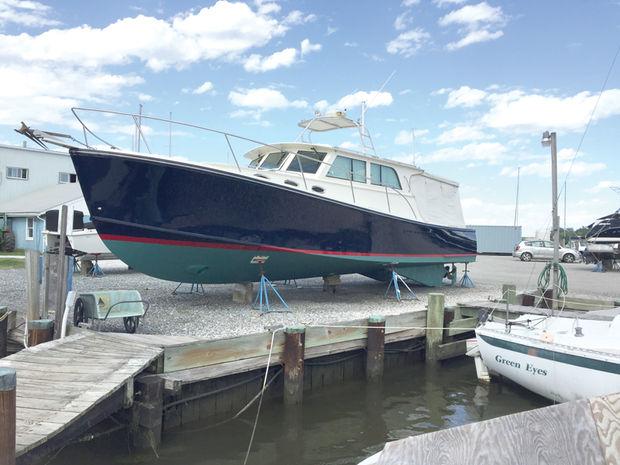
From dream to boat: the steps
When you come to a boat builder with an idea in mind, maybe your dream boat, there could be substantial design discussion before you draw up a contract, put down the first deposit, and go through the steps of building. Glyphis says, “Normally, you want to try to get (the customer) a ride on one of the boats you’ve built already, and then we’ll start tailoring it to what they want.”
Rob Hardy at Composite Yacht in Trappe, MD, describes a customer who wanted an inspected charter boat for wounded warriors with “plenty of room, no steps, no engine boxes. He couldn’t find a boat that fit that. We own so many different molds—offshore, deadrises, skiffs—but nothing really fit the criteria he was looking for.” He notes that fishermen like the open-cockpit style of the deadrise and says, “We wanted to make something with a lot of those attributes that would be capable of fishing in open water.” They sat down with the idea and went through the initial design. “We work with shapes. We have a local guy who recently graduated from naval architecture school, so we hired him to work with Dad (Martin Hardy, the owner) to design this new 46, which got digitized through a CAD program,” he says. “At that point, we build it similarly to a cold-molded boat, but we’re building it out of high-density coring material.”
Floyd says that at F&S, “The most important thing for us is that we’re on the same page as the client. We build a very specific kind of boat—we’ve changed over the years—the boat is closer to a yacht than we ever thought they’d be. My uncle [Jim], who’s still the owner, wants first and foremost to build a sportfishing boat. It may feel like a yacht, but it’s a sportfishing boat.” If the design ends up compromising their own style, they will pass on a project, because they can’t meet expectations and build the right boat.
At Mast and Mallet, Reid’s steps are “figuring out the design, start laying out the priorities, define the shape (power or sail), amenities that are confined to this shape (galley up or down), what kind of headroom or space, more bunks, refrigeration or not… lastly, the price range and budget.” The contract will include the time period, initial deposit, one when the hull is built, another when a few other requirements are met (power, building a house, or the like), and then the finish work. The final payment is expected after the sea trial.
A couple of boat builders noted that their process is similar to that of building a home. Hardy says, “When we create a mold, the initial buyer has to know that it will take longer, because that takes time and expense… You need an understanding client. It helps if you’ve worked with them before, so they understand what you do.” The process, he says, “depends on the client, depends on the build.”
At Eastern Shore Boat Works, Glyphis says, “We’re backyard boat builders, so we do things on a handshake here. It’s kind of old school, but back in the day that’s how it worked. We give (the customer) a projected cost to the best of our knowledge and experience. Resin prices change… there are a number of factors that change. You’re going to put a lot more effort into the fit and finish; the process takes a lot of time.”
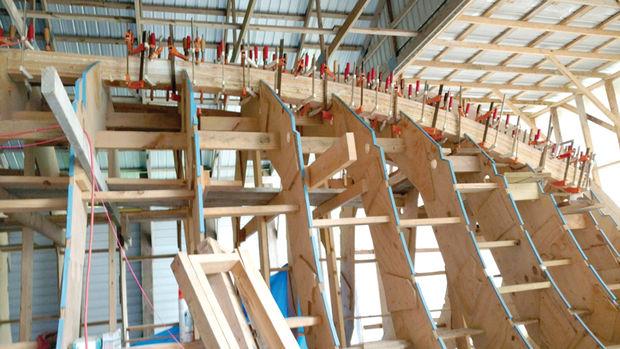
What’s in the shop now?
One thing became quickly apparent when talking to Chesapeake region boat builders: all they really want to talk about is what they’re working on right now. At Composite Yacht, Hardy says, “The most significant new thing we have going on is a 46-footer. We own the molds for the Markley hull, but it’s not an easy boat to get inspected, so we decided to start from scratch. (This 46-footer) has more shape than the Markley, and is larger, with more beam, more freeboard, a lot of flair, an aggressive running bottom. We will be able to get engines below deck, which will really open things up on deck. It’s a combination deadrise and offshore boat that will be a charter boat. The hull is upsidedown and in the fairing stage now; it’s an all-composite build. Once this hull is done, we’ll keep the mold.”
Floyd says that at F&S, “We’re currently building (hull numbers) 27, 28, 29. Hull 27 is a 78-foot flybridge called the Special Situation, with five state rooms and four heads and full crew quarters. It’s our biggest build to date (we’ve done a couple 75s). The boat will be launching in June… we started this boat in July 2015.” He says, “All of our boats are 100-percent cold-molded and hand-crafted. We build every square inch of the boat.”
At Eastern Shore Boat Works, Glyphis says, “I wanted to build a big boat. I love offshore fishing. I got with a builder in North Carolina named Billy Holton. He was one of the original boatbuilders down there. He built more than 100 boats in different sizes. I got on a boat called the Playmate, and I liked the way she rode. I went down there and found the man.” “We talked, and he agreed to build me a set of jigs. He got with a computer guy down there… I sent him some plywood. I went down and picked up the jig. I’ve been working on it for two years. We’re putting wood on the hull now. It’s 60 feet long.”
Of the 22-footer he’s building at Mast and Mallet, Reid says he’s made her on spec. He likes boats with a traditional Chesapeake Bay boat feel. She’s shaped similarly to a Smith Island crab scrape, but a bit smaller “for trotlining, fishing, mucking around in creeks and streams, and going out in the boat a little bit.”
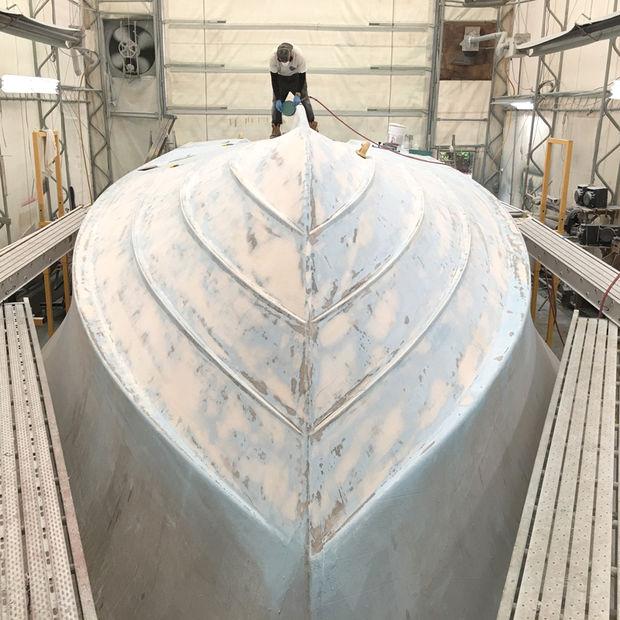
The tough parts
The greatest challenge of building custom boats for Hardy depends on the build. “On a new build like this, it’s crossing your finger and hoping it works,” he says and laughs. “We are actually really confident. We have a ton of experience under this roof.” “The challenge is providing a project that meets expectations and stays within the budget. I’ve had to shy away from customers whose budgets don’t match their expectations—champagne taste on a beer budget. Hand built, hand formed, hand finished: the budget will vary with the finish… You have to get a sense of the client going into it.”
Floyd spends a considerable amount of time thinking about, “Meeting customer expectations. Clients tend to think in terms of their home. Some of our customers may have many homes… you may build a salon with $80,000 worth of furniture. They change their minds and have it moved around. Rip it out and build a new table. It’s their money. It may be a lot of energy and time, but that’s what we do. We are a custom builder. We do whatever they want, but that can make it tough.” “The second thing: there are far fewer skilled laborers in the marine industry. It’s much harder than it was in the past to find people who can work on boats. We’re lucky; we’re in Bear, DE, with no other builders around. Probably 16-20 of our 30-person staff have been here in excess of 10 years.”
Glyphis notes the most daunting part of his latest project: “The size of it. It’s my first 60-footer. I’ve been basically working alone for two years getting everything situated. It’s tough work, but you have to have a certain eye for things, know what the overall process is. Getting things straight and level and square. Getting your jigs set up so that the boat is aligned correctly. There’s a lot you can mess up, but there’s a lot you can’t mess up.”
Reid focuses on “getting to the point where I get a good feeling from the customer about what they’re feeling, certain pinpoints to make this deal go through. It takes on a personal touch… it’s like building a good friendship.”
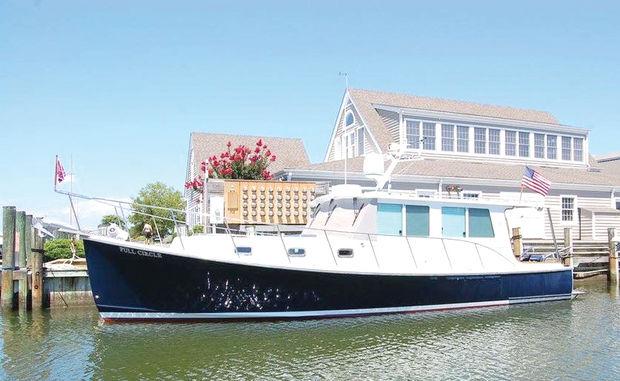
The most gratifying part
For Hardy, who works with his father, Martin, and brother, Lewis, the most satisfying part of the process is “The finished product! That’s why everybody does it. It’s certainly not for the money. When the new boat is in the slip, there’s nothing like it.”
Floyd says that the best part is “Doing what I love. Building boats. Making something out of nothing. When you’re a boat builder and you’re doing a custom boat, you leave a little piece of yourself in it. You learn from it. You learn all the time. You’ve got to keep your mind open. New things come up that make it easier for you.” “Custom boatbuilding is pretty archaic,” he says and describes his past work in a production shop for cars and machine shop for Harley. “Boat building is all hands on: fitting the wood, getting the seams tight, making sure everything flows right on the boat. It’s different than just filling up a mold. When all this fiberglass and wood starts to take shape, it’s an awesome feeling.”
The most gratifying part for Reid, who’s been building boats for 34 years: “You’re building something that’s going to continue with this person, couple, or family in life. You’re going to get to know them like cousins or family for the rest of your life.”
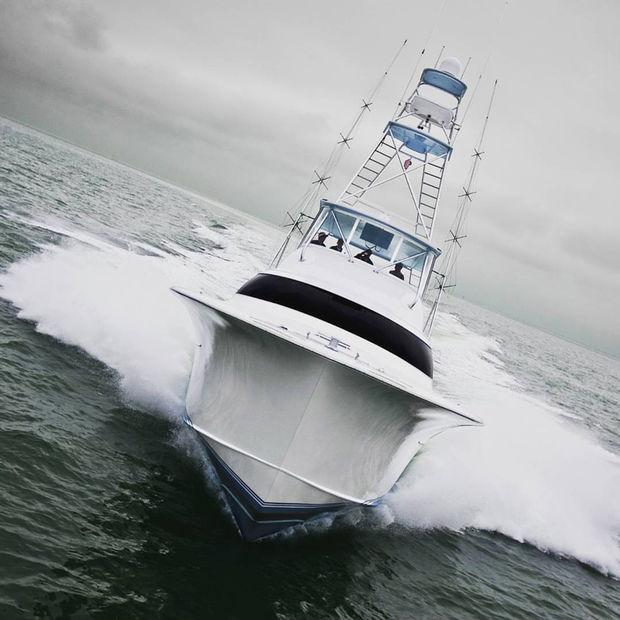
by Molly Winans, edited by Capt. Rick Franke